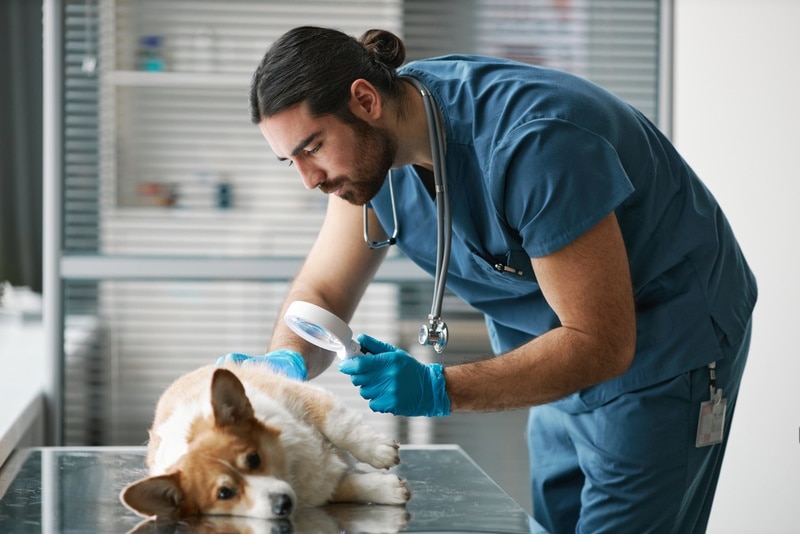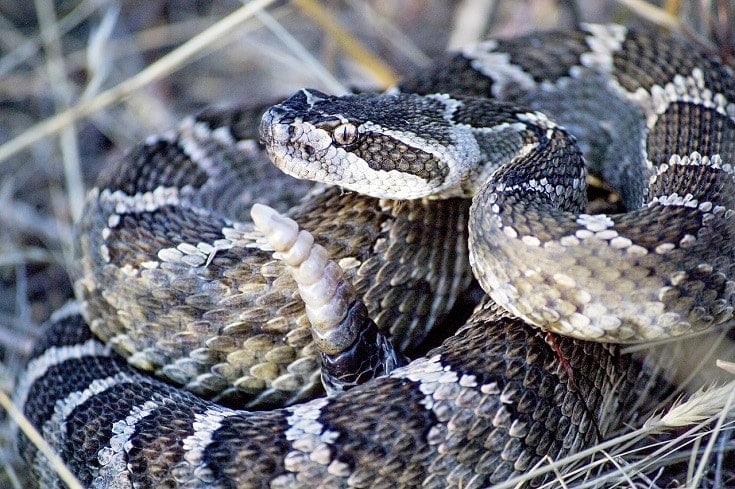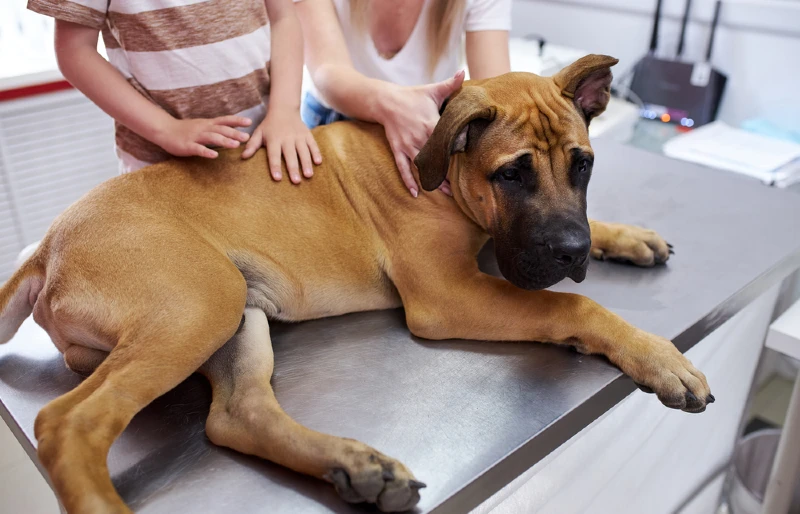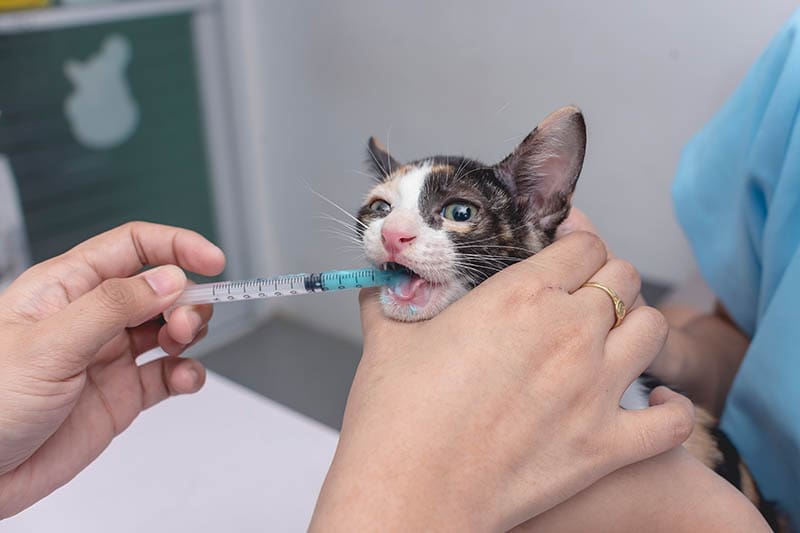Rattlesnake Bites in Dogs: Vet-Explained Prevention, Treatment & Emergency Care
Updated on

Click to Skip Ahead
Rattlesnakes pose a significant health threat to dogs when placed in a situation where they bite the pet. They will attempt to warn away dogs and their owners as best they can but despite the best intentions of both the snake and the owner, dogs will sometimes unknowingly wander too close to or go to investigate a rattlesnake and be bitten.
Rattlesnake bites are an emergency situation.
Upon learning your dog has been bitten by a rattlesnake or any snake you suspect to be one, they must be taken to the closest emergency veterinary clinic immediately. All the other details you need to know about rattlesnake bites have been collected here.
Why Are Rattlesnake Bites Dangerous?
There are many different species of rattlesnakes, all more common in certain areas, but what they all have in common is that they’re all venomous.
Rattlesnakes have venom-producing glands in their head that transport venom through venom ducts and glands and into hollow fangs to eject into prey when the fangs are embedded during a bite.
Different venomous snakes produce different venoms, and individual rattlesnake species will produce species-specific venoms too. Rattlesnake venom is mostly a hemotoxin but also a neurotoxin.
Hemotoxins inhibit clotting to cause bleeding and cause significant cell death of tissues around the bite. They break down the structures of blood vessels and tissues to increase bleeding and are particularly good at killing muscle cells.
Neurotoxins aim to subdue prey. They affect the nervous system and can cause weakness or even paralysis.
Rattlesnake venom can also trigger a dog’s immune system to attack its own cells, greatly increasing the damage a bite can cause.
Due to all these factors, rattlesnake bites are very good at becoming life-threatening very quickly with increased bleeding, rapid onset cell death that spreads, and an immune system that can go into overdrive and kill the pet.

What Are the Signs of a Rattlesnake Bite in Dogs?
The signs of a rattlesnake bite can differ based on the species responsible and even which local population it was, as different regions seem to host a rattlesnake species with differing ratios of toxins in their venom.
- Presence of a rattlesnake paired with a wound
- Unsteady wobbling
- Paralysis
- Severe pain at the sight of a bleeding wound
- Sudden collapse or falling unconscious
- Lethargy
- Respiratory distress
- Loss of appetite
- Trouble swallowing
- Tissue swelling, especially around the wound or face
- Loss of clotting ability
- Nose bleed
- Diarrhea or vomiting, with or without blood
- Fever
- Bloody urine
- Drooling
- Muscle twitches
- Dilated pupils
- Irregular or weak pulse, fast heart rate
- Seizures
As you can see, there are many likely signs of a rattlesnake bite. The first signs are usually a bleeding wound, pain, and maybe some weakness or unsteadiness, which progresses to the others very rapidly. The smaller the dog, the more severe the signs are likely to be and the more rapidly they are expected to progress.
Sudden death immediately after a rattlesnake bite is unfortunately possible.

What Are the Causes of a Rattlesnake Bite?
Rattlesnakes do not want to bite and do not go out of their way to find a dog and bite them. Rattlesnakes are nocturnal animals, and sometimes dogs finding where they are sleeping can startle them and cause them to bite before they even get a chance to rattle.
Usually, a rattlesnake will try to rattle as a warning to encourage a dog to move away. Venom is metabolically taxing to produce, and the snake does not want to use it frequently for anything besides catching prey it intends to eat, which is typically not a dog.
Dogs that do not understand how to heed a warning from a rattlesnake may instead go to investigate, which can lead to a bite.
How Is a Rattlesnake Bite in Dogs Diagnosed?
In the best-case scenario, an owner watches the dog be bitten by the snake, and the bite is therefore diagnosed immediately.
Sometimes a dog will be wandering through grass, off the path away from the owner on a hike or walk and suddenly cry out and come back stumbling or limping with a bleeding wound. At this point, a venomous snake bite is usually suspected as little else can cause the progression of signs that is beginning, but unless the owner happened to hear the rattle or can easily see the snake, it may be impossible to know that it was a rattlesnake specifically that bit the dog. In some regions, rattlesnakes are the only venomous snakes and may even only have one species of rattlesnake, which can help with diagnosis.
If your dog is bitten by a snake and you can safely and quickly either take a picture of the snake or identify the snake definitively yourself, this should be done, as antivenom is species-specific, so this information is needed if at all possible.

How Do I Care for a Dog With a Rattlesnake Bite?
As soon as you realize your dog has been bitten by a snake, the dog needs to be kept as still as possible, the wound needs to stay below the heart if possible, and you need to start moving to the closest veterinary ER as soon as possible. The only thing you should stop to do is identify or take a picture of the snake if you can.
You also need to call ahead to the veterinary ER to warn them you’re coming and check if they have antivenom, as not every veterinary clinic and ER does. If there are several ERs in a small area like a city, antivenom may only be kept at certain clinics, and the veterinary clinic you contact may reroute you to a different ER if they don’t think it is too far. Only proceed to a veterinary clinic instead of an ER if an ER is unavailable and still call ahead to the clinic.
There are some important things to not do in the event of a rattlesnake bite that you might think you’re supposed to try.
- Do not try to suck out the venom. It is no longer in the area, and you want to manipulate the wound as little as possible.
- Do not apply an ice pack or tourniquet. You do not want the venom to sit contained in one area due to less blood flow, as this can cause significant worsening of tissue death and bleeding in the area of the wound.
- Do not cut over the wound. Again, the venom is no longer sitting here, it is in the bloodstream, and you cannot release it out of the wound by cutting. All you will accomplish is creating a cut that likely cannot clot and will increase bleeding.
- Do not try to collect or kill the snake. The veterinary clinic does not need nor want the snake. Trying to catch or kill it wastes precious time and is very dangerous. Instead, take a picture of the snake and then get moving to the ER.
- Do not give your dog anything unless told to do so by a veterinarian.
- Do not let your dog get their heart rate up. If it is at all possible to carry your dog to the car after they’ve been bitten, you should do this. Otherwise, walk them slowly, leaving the area with the wound as immobile as you can.
The single most important things to remember after a dog is bitten by a rattlesnake are to identify the snake when you can. Otherwise, take a picture, and get to the veterinary ER as fast as you can without making your dog run.
How Is a Rattlesnake Bite in Dogs Treated?
Rattlesnake bites need to be treated at a veterinary clinic, preferably a veterinary ER. Antivenom can be administered if it’s available and the species of rattlesnake is known, but antivenom is very expensive and can cause reactions in some dogs, so it is not without risk.
Fluid support and blood transfusions may be needed to deal with shock, bleeding out, and loss of the blood’s clotting ability. Large wounds are likely to develop at the site of the bite even after initial stabilization, with large areas of tissue dying, needing to be removed, and leaving gaping wounds that cannot be closed and expose underlying muscles, bones, blood vessels, and nerves. These dogs need careful wound care, antibiotics, and possibly multiple surgeries.
Organ failure may occur, and regular bloodwork screenings are needed to monitor this situation. Controlling the immune system can also help with treatment.
Dogs bitten by rattlesnakes are typically hospitalized for at least a day but, in severe cases, may be hospitalized for a week or more. The sooner a dog gets to a veterinarian, the better the prognosis.

How Can Rattlesnake Bites in Dogs Be Prevented?
Dogs can be trained to recognize the smell and/or sound of a rattlesnake and avoid them. Training classes are usually readily available in areas with large rattlesnake populations.
Training a dog with the “leave it” command or something similar can also be very helpful. If you are with your dog and see them notice a rattlesnake, you can keep them from approaching.
Always walking a dog on a leash significantly decreases the chances of a rattlesnake bite.
There is also a rattlesnake vaccine, which doesn’t prevent a bite or a reaction to a bite but can buy a dog more time to reach the ER. The rattlesnake vaccine is only helpful for protecting against western diamondback rattlesnake venom and has not yet been proven to be truly effective, so it is not readily available at all veterinary clinics.
If moving around tall grass, it is best to make lots of noise so a snake can hear you coming and to not listen to music on headphones, so you can hear the snake rattle’s warning.
Rattlesnake fencing exists that is specifically designed to keep rattlesnakes from entering a yard.
Frequently Asked Questions (FAQs)
Can dogs survive rattlesnake bites?
Most dogs will survive though the size of the dog and how much venom they were injected with greatly affects their prognosis, as does timely treatment.
How serious is a rattlesnake bite to a dog?
A rattlesnake bite is always an emergency! Do not delay and bring a dog straight to the nearest veterinary ER or clinic if you suspect they’ve been bitten.
Can dogs survive rattlesnake bites without antivenom?
Yes, they can. Antivenom is not always readily available, and not all owners can afford it as part of treatment, but it is best to use it if you can.
Conclusion
Realizing your dog has been bitten by a rattlesnake is understandably scary. As long as the bite is recognized quickly and the pet is transported to a vet immediately, most dogs will survive, though treatment is expensive, and recovery may be a long process. Avoid trying to intervene with home remedies or actions for the bite and instead bring a bitten dog straight to the vet as much of what you know from movies and popular culture about first aid after a snake bite is wrong.
The best offense is a good defense when it comes to rattlesnake bites. Setting a dog up for success by training a “leave it” command, utilizing rattlesnake avoidance training classes if available in your area, and keeping them on leash on hikes to prevent a bite from ever happening is the best thing you can do for rattlesnake bites.
See also:
- Black Fly Bites on Dogs: Our Vet Explains Signs, Treatment & Prevention
- Dog Bitten by a Rat? Our Vet Explains What to Do Now
Featured Image Credit: SeventyFour, Shutterstock
















